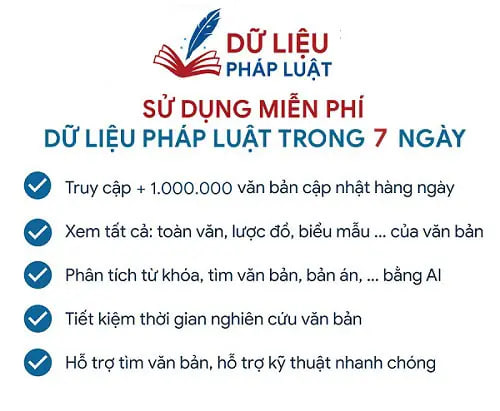Tin văn bản
NÓNG: Giá xăng, dầu hôm nay giảm mạnh
Ngày 11 tháng 10 năm 2023, Bộ Công Thương đã ban hành Công văn 7075/BCT-TTTN về việc điều hành kinh doanh xăng dầu.
Kiến thức pháp luật
Phải nhận biết khách hàng trong phòng chống rửa tiền
Rửa tiền là gì? Những trường hợp phải nhận biết khách hàng trong phòng chống rửa tiền được quy định như thế nào?
Về chúng tôi
Dữ Liệu Pháp Luật là ứng dụng hỗ trợ tra cứu văn bản pháp luật Việt Nam và quản lý dịch vụ pháp lý.
Dữ Liệu Pháp Luật giúp quý khách truy cập truy cập vào cơ sở dữ liệu pháp lý phong phú, chính xác. Đồng thời hỗ trợ tổ chức và cá nhân trong việc lưu trữ, theo dõi và xử lý các công việc liên quan đến pháp luật.
Biểu mẫu
Công cụ
Lĩnh vực
- An ninh Quốc gia (25)
- An ninh mạng (11)
- An ninh trật tự (104)
- Bảo hiểm (5,357)
- Bất động sản (23,275)
- Bộ máy hành chính (18,651)
- Chính sách (259)
- Chưa xác định (1)
- Chứng khoán (168)
- Cán bộ - Công chức - Viên chức (125)
- Công nghiệp (316)
- Công nghệ thông tin (13,403)
- Công nghệ- Thực phẩm (96)
- Cơ cấu tổ chức (383)
- Doanh nghiệp (2,666)
- Du lịch (14)
- Dân sự (15,689)
- Dịch vụ pháp lý (578)
- Giao thông (93)
- Giao thông - Vận tải (9,668)
- Giáo dục (2,759)
- Hàng hải (6)
- Hành chính (80,084)
- Hình sự (36,343)
- Hóa chất (721)
- Hôn Nhân Gia Đình (19,502)
- Hôn nhân và gia đình (5)
- Khoa học - Công nghệ (79)
- Kinh doanh thương mại (11)
- Kinh tế (1,731)
- Kế toán - Kiểm toán (2,723)
- Lao động (15,337)
- Lao động - Tiền lương (3,117)
- Lâm nghiệp (6)
- Lâm nghiệp - Ngư nghiệp (14)
- Lĩnh vực khác (191,695)
- Ngoại giao (21)
- Nông nghiệp (2,336)
- Quyết định tuyên bố phá sản
- Quyết định áp dụng biện pháp xử lý hành chính
- Quyền dân sự (4,189)
- Quốc phòng (3)
- Sở hữu trí tuệ (1,001)
- Tham nhũng
- Thi đua - Khen thưởng - Kỷ luật (42)
- Thiên tai (3)
- Thuế - Phí - Lệ Phí (44,202)
- Thông tin - Truyền thông (127)
- Thương binh - xã hội (2)
- Thương mại (33,023)
- Thể thao (16)
- Thể thao - Y tế (2,890)
- Thủ tục Tố tụng (143)
- Thực phẩm - Dược phẩm (53)
- Tiết kiệm-Phòng, chống tham nhũng, lãng phí (34)
- Tiền tệ - Ngân hàng (1,232)
- Trách nhiệm hình sự (234)
- Tài chính - Ngân hàng (6,968)
- Tài chính nhà nước (28,477)
- Tài nguyên - Môi trường (16,958)
- Tài nguyên - Môi trường (852)
- Tài nguyên môi trường (20)
- Tư pháp - Hộ tịch (216)
- Tố tụng (1,170)
- Vi phạm hành chính (2,048)
- Văn hóa (16,443)
- Văn hóa - Xã hội (3,738)
- Xuất nhập khẩu (33,062)
- Xây dựng (16,708)
- Xây dựng (1,710)
- Xây dựng - Đô thị (5,037)
- Y tế (12,992)
- Điện - điện tử (151)
- Điện lực (15)
- Đào tạo (4)
- Đất đai - Nhà ở (301)
- Đấu thầu - Cạnh tranh (4)
- Đầu tư (20,366)
- Địa giới hành chính (2)
Công điện 94/CĐ-TTg năm 2024 về tăng cường công tác vận hành, điều tiết các hồ chứa thủy điện ở các tỉnh phía Bắc nhằm đảm bảo an toàn hệ thống đê và giảm thiểu đến mức thấp nhất thiệt hại do ngập, lụt tại vùng hạ du do Thủ tướng Chính phủ điện
| | |
Quyết định 37/2024/QĐ-UBND về Quy định hạn mức giao đất, hạn mức công nhận đất ở, hạn mức nhận chuyển quyền sử dụng đất nông nghiệp; điều kiện tách thửa đất, hợp thửa đất; diện tích tối thiểu được phép tách thửa đất, hợp thửa đất trên địa bàn tỉnh Hải Dương
| | |
Tiêu chuẩn quốc gia TCVN 13906:2024 về Xỉ thép làm vật liệu san lấp
| | |
Tiêu chuẩn quốc gia TCVN 13929:2024 về Bê tông - Phương pháp thử tăng tốc Cacbonat hóa
| | |
Tiêu chuẩn quốc gia TCVN 13933:2024 về Bê tông - Phương pháp đo chiều sâu cacbonat hoá
| | |
Tiêu chuẩn quốc gia TCVN 13930:2024 về Bê tông - Phương pháp xác định tốc độ hút nước
| | |
Công văn 3987/TCT-CS năm 2024 về chính sách tiền thuê đất do Tổng cục Thuế ban hành
| | |
Công văn 3989/TCT-CS năm 2024 về Chính sách tiền thuê đất do Tổng cục Thuế ban hành
| | |
Công văn 3993/TCT-CS năm 2024 về Chính sách thuế do Tổng cục Thuế ban hành
| | |
Công văn 3992/TCT-CS năm 2024 về Chính sách thuế do Tổng cục Thuế ban hành
| | |



